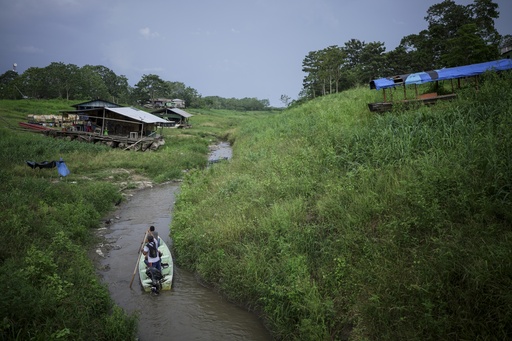
Leticia, Colombia — At the age of 69, Marciano Flores immersed himself in the Amazon River, alongside his crew, preparing to pull in a massive fishing net. A fisherman from the Cocama Indigenous community, Flores has spent his entire life navigating the river, able to identify the best fishing spots instinctively. However, one year ago, accessing the river would have been impossible; its waters were significantly higher. Now, with the river’s levels drastically diminished, the crew’s efforts yielded little, forcing them to venture further downstream in search of a smaller catch. This declining harvest is increasingly burdensome, pushing up fuel costs for Flores and his fellow fishermen.
“The drought has heavily impacted me,” Flores mentioned. “When the water is low, the fish die, leaving us with nothing to catch.” While seasonal variations in the Amazon River are normal, the past year has seen an alarming downward trend in water levels—particularly in Brazil—which has started to reverberate through other Amazonian nations. The consequences are dire, threatening local economies and food security.
In Colombia, the reduced water levels have impacted remote Indigenous communities, leading NGOs and government agencies to deliver vital water and food supplies. For many, securing basic necessities now involves a challenging trek across parched earth. In some regions, children must walk two hours just to reach school, as river transport is no longer an option. According to Colombia’s National Unit for Disaster Risk Management, the river has dipped by 80% to 90% in recent months.
“I am genuinely worried, especially for the Indigenous communities affected, as they have exhausted their food supplies,” stated Álvaro Sarmiento, who oversees operations at the Civil Defense in Amazonas. “Fishing is essential for Indigenous diets.”
Large expanses of sand now emerge where the river once flowed, a clear indicator of the severe drop in water levels. The stark contrast is evident along the riverbanks, where sunbaked earth has cracked and eroded into the remaining water. High water marks on tree trunks serve as reminders of what once was.
“In the 35 years I’ve been in the Amazon, I’ve never seen it this low,” lamented 61-year-old Jugalvis Valencia, a tour guide. He expressed concern that if drought conditions persist into the next year, some river sections could completely dry up, isolating local communities even further.
In La Playa, a community near Leticia, 48-year-old Ermencida Miranda operates a small shop, providing essential items to the area where Colombia, Peru, and Brazil meet. She voiced her worries over dwindling water resources, saying, “In all the communities… we are suffering because of the water; the drought is terrible.” Having relocated from Putumayo eight years ago in pursuit of better prospects, Miranda explained that the community relies on river water for bathing, but cooking and drinking require rainwater collection—or purchasing expensive water from Leticia when rainfall fails.
Further downriver, approximately 32 kilometers away, resides the Indigenous reserve of Santa Sofia, home to around 2,400 individuals from five tribes. Locals gathered under the shade of mango trees, waiting for supplies dispatched by a nonprofit. In previous years, the river almost reached the trees; today, the water is so low that a five-minute walk across dry, cracked mud brings them to the river’s edge.
The nonprofit brought essential provisions, including lentils, rice, and cooking oil, along with large cisterns designed for rainwater storage. Community members assisted each other in transporting bags filled with supplies back home and collaborated to move the heavy cisterns.
“Getting food has been challenging, and transporting our crops to Leticia is difficult because of the drought,” said Elder Kawache, a 47-year-old resident of Santa Sofia. In his eyes, lack of access to drinking water has been among the most challenging aspects of the drought, especially since their local well has also run dry.
Although Colombia’s environmental ministry did not provide a comment, the National Unit for Disaster Risk Management announced plans to equip isolated areas with motorized pumps and hoses for water access. They also indicated intentions to explore underground water sources and are sending humanitarian assistance containing clean water and non-perishable food.
Peru has declared a state of emergency, pledging to supply medicines and chlorinated water to communities near the river, while Brazil offers potable water and purification systems to affected regions, alongside plans to expedite welfare payments for low-income families.
Although the river has experienced slight increases in water levels in certain areas recently, locals remain apprehensive about their situation next year, particularly as the drought intensifies. Miranda has seen no assistance from government entities at her store and hope for an elevated water tank persists, as it would alleviate the burden of fetching water during the dry season.
“If someone could support us in securing water, it would bring joy and transform our lives,” Miranda expressed. “Because water is essential for us.”
